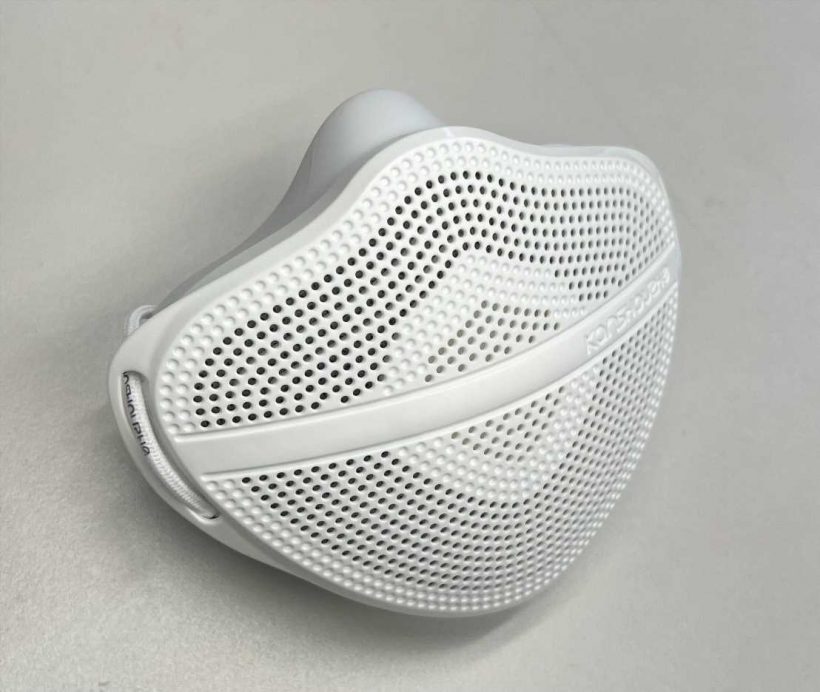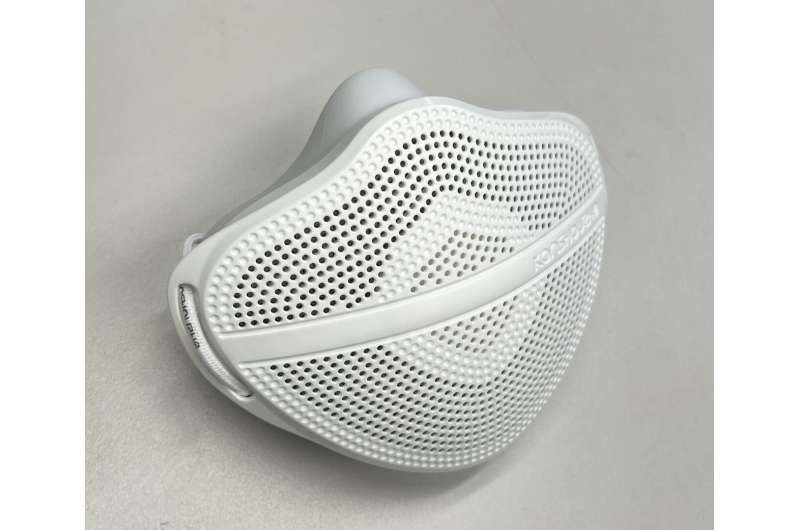
Electrostatic adsorption is an important complement to mechanical filtration for high-efficiency air filtering in the use of face masks. However, the electrostatic charge of the filters decays over time, particularly in humid conditions.
A research team at City University of Hong Kong (CityU) successfully engineered a breath-to-charge electrostatic face mask that can “self-charge” through the user’s breathing and continuously replenish its electrostatic charge as the user wears and breathes through the mask. This significantly increase the filtering performance in prolonged use of the mask for up to 60 hours, compared to four hours for a conventional surgical mask. This also benefits the environment.
Face masks are an easy, cost-effective method of preventing COVID-19 and other airborne diseases. Most face masks have three functional layers: a core melt-blown polypropylene (PP) layer as the filter medium and two spun-bonding nonwoven fabrics (generally PP or polyethylene (PE)) as the supporting layers, including a hydrophilic layer, worn inwards, to absorb moisture from breathing and a hydrophobic layer, worn outwards, to repel fluid.
Tackling the problem of electrostatic adsorption efficacy decline
Electrospinning provides better mechanical filtration than the melt-blown technology extensively used in the industry. But mechanical filtration alone does not provide enough protection. One solution is to introduce an electric field to give the filter medium an electrostatic charge, which facilitates ultrafine particle trapping. However, the electrostatic adsorption efficacy declines over time, especially in a humid environment when moisture is exhaled in breathing.
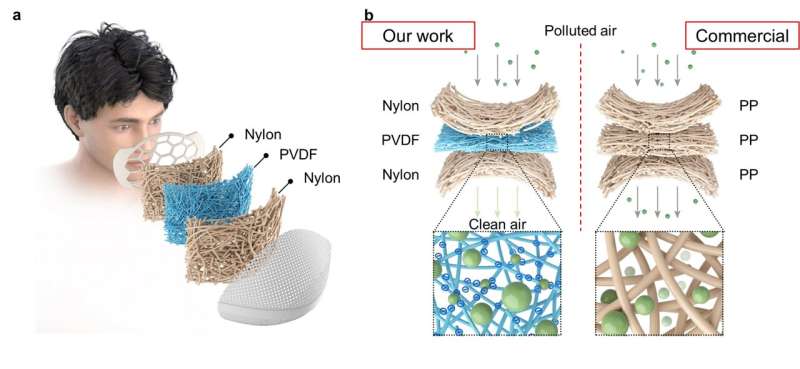
“Although many reports work on replenishing the charge for long-lasting electrostatic adsorption efficacy, an extra power source is generally needed, which is cumbersome and inconvenient,” explained Dr. Yang Zhengbao, Associate Professor in the Department of Mechanical Engineering and the Department of Materials Science and Engineering at CityU, who led the research. “We have developed an efficient, durable, low-cost air filter that can continuously replenish the electrostatic charge in a self-charging manner.”
The research team introduced a self-charging air filter (SAF), which leverages the triboelectric effect and achieves efficient and prolonged airborne particle removal. By sandwiching the electrospun polyvinylidene fluoride (PVDF) nanofiber filter medium between two triboelectric nylon fabric layers, the SAF continuously generates electrostatic charges excited by breathing. As a result, the SAF provides durable particle removal performance, maintaining high efficiency of 95.8% after 60 hours of testing (including 30 hours of wearing).
“As the middle layer moves forth and back between the lateral layers with breathing, a charge transfer occurs between PVDF and nylon due to their large difference in electron affinity, resulting in the PVDF layer being negatively charged and the nylon layers positively charged,” explained Dr. Yang. “This self-charging process enables the continuous replenishment of the electrostatic charges and prolonged electrostatic adsorption.”
-
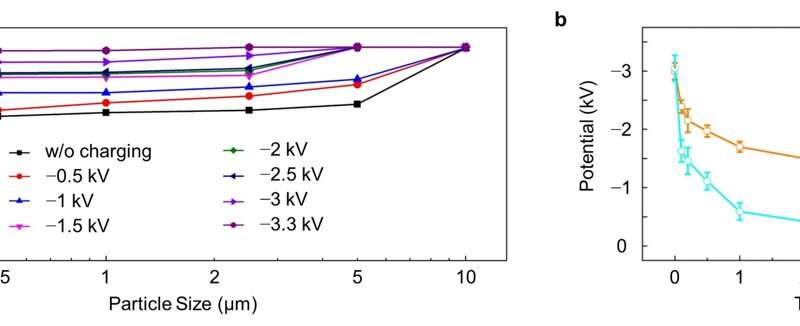
Quantitative relation between surface potential and filtration efficiency. (a) Grade efficiencies for particles ranging from 0.3μm to 10μm under various surface potential. (b) Electrostatic potential attenuation under 20% and 50% relative humidity. Credit: Dr Yang Zhengbao’s Group / City University of Hong Kong
-
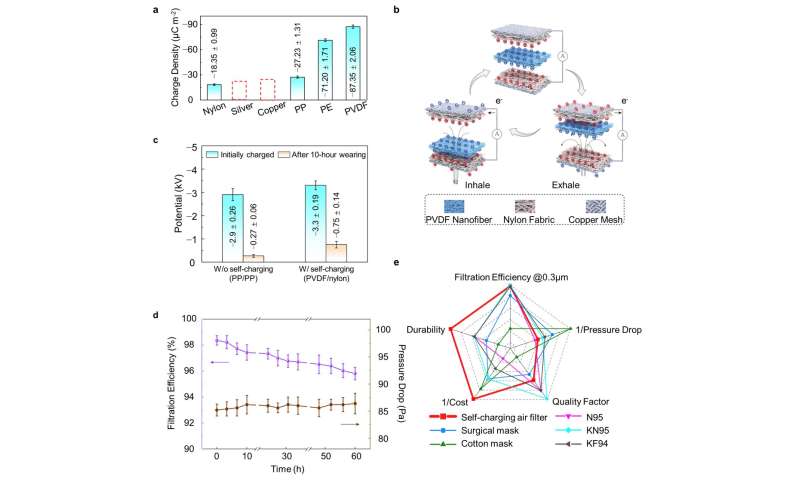
Efficient and durable triboelectric effect-enabled PM filtration. (a) Triboelectric series: comparing the charge transfer capacity of the studied materials. The dashed bars represent a qualitative ranking. (b) Triboelectric charge generation mechanism of the SAF. (c) Electrostatic potential attenuation with and without the self-charging function, indicating prolonged electrostatic adsorption capacity with self-charging. (d) Durability evaluation of filtration efficiency and pressure drop. (e) Radar chart comparing the performance of the SAF with commercial face masks. Credit: Dr Yang Zhengbao’s Group / City University of Hong Kong
‘Self-charging’ driven by the user’s breath
The raw material cost of SAF for making one mask is as low as HK$0.47, making it the most cost-effective option among the commonly used masks, such as surgical, N95, KF94 and KN95 masks.
The findings were published in Nature Communications.
This promising strategy of self-charging to leverage the triboelectric effect paves a new path for the development of high-efficiency, long-lifespan air-filtering techniques.
“Surgical masks are suggested to be changed every four hours in a high-risk environment, but the vast number of discarded masks results in severe environmental challenges,” said Dr. Yang. “We expect this self-charging strategy to significantly prolong the service life of face masks, enhance the protection effectiveness against the coronavirus, and reduce the environmental burden caused by discarded masks.”
The research also established a quantitative relationship between filtration efficiency and surface electrostatic potential, which is important for standardized, high-efficiency industrial production.
More information:
Zehua Peng et al, Self-charging electrostatic face masks leveraging triboelectrification for prolonged air filtration, Nature Communications (2022). DOI: 10.1038/s41467-022-35521-w
Journal information:
Nature Communications
Source: Read Full Article
